Determined to make my tree selection as planned by Friday, April 12th, I winnowed the 13 on my spreadsheet below down to the two that, in the end, most emotionally appealed to me: a Catalpa and a Ginkgo.
My tree choices
The Catalpa would adorn my parklawn/easement, between sidewalk and street curb on the east side of my driveway, in the spot where walkers cross from the Boulevard. There is still a slight depression where we’d dug the hole for the Catalpa volunteer that folks on a neighboring street had offered for free on Nextdoor. That would be the one that died in an August heatwave while we were out of town.
The Ginkgo Biloba would be planted at Royal Oak’s Mahany-Meininger Senior Community Center, where Springfed Arts has rented rooms for me to teach many of my writing workshops. That is, if I could work out such a plan with the city or the Royal Oak Nature Society, whichever entity is responsible for supervising what gets planted there.
Royal Oak tree history sunning on the beach
After making my decision, I left Royal Oak to open our cottage over the weekend. And, what often happens, given the magic that resides on Pelee Island, my plan changed. I ended up spending a fair amount of Saturday wrapped in a blanket lying in the sun on the beach entertaining a cold virus. While I was thus reclined, I perused a pile of four books on the history of Royal Oak.

I had checked these books out of the library and then renewed them twice, not because they were so fascinating–which they ultimately were–but because I hadn’t had time yet to get between their covers. But now, laid low by the virus, I did. And, I was surprised to see how many mentions of trees were in the books, probably due to the legend of how Royal Oak got its name (a story for another day).
But are the trees native to Royal Oak?
Last week, someone (this someone might have been Harah F., but she’s not fessing up, and as she has the flu, I’m leaving her be) asked if I’d made my decision and when I told her the two trees I was thinking about, she asked, “Why would you plant anything that wasn’t native?” While Northern Catalpa trees are, in fact, native to the midwestern United States, the Ginkgo Biloba is native to China.
Around the same time, Julie F., the city assessor and wonderful bestower of earlier photos of my yard, sent me an e-mail with the subject line “Trees in Arboretum” about the Royal Oak Arboretum, located next to the Mahany-Meininger Senior Community Center:
You might already know this, but if not…[the Royal Oak] Arboretum … has [65] species of trees native to Mich[igan and 5 in their nursery. That leaves only 16 native trees that they need to get in order to have all 86 native Michigan trees]. I thought you would be interested. Here’s the link:
https://www.romi.gov/
DocumentCenter/View/19606/Arboretum-2017?bidId=
Over the weekend, with nothing to do but lie sick on the beach, I got curious. What 86 trees are native to Michigan?
The Michigan Department of Natural Resources lists 32 species in their Michigan Native Trees. Of those, 5 were on my list of 13 possibilities: White Pine, Ohio Buckeye, Paper/White Birch, Oak (5 varieties), and Eastern Redbud.
Michigan State University’s MSU Extension Service has a list of 13 or 14 native species (depending on whether your soil is acidic enough to support a Pin Oak). Of those, only 2 were on my list: Oak and Eastern White Pine.
But now, what I really wanted to know was . . .
What trees grew here before the settlers removed them?
Specifically, what trees grew here, in what was to become known as Royal Oak, when the first Europeans surveyed the territory? Here are the two answers I found in Royal Oak history:
“. . . the glorious swamp oak trees of Royal Oak . . . have never been, nor could be adequately described. They were, indeed “Royal Oaks,” trees [that] were 15- feet high and 9 feet thru. . . .
The whole north and west section of the [Royal Oak] township outside of the marshes and sand ridges were covered not only with the oak trees mentioned, but a heavy growth of beech, maple, basswood or linden, elm of various varieties, hickory, tulip trees or white wood, black and white ash, and some black walnut and butternut.
–excerpt from royal Oak, michigan by ralzemond A. Parker, 1921, reprinted in Royal Oak Twigs and Acorns plus: articles, essays, letters and other historical writings compiled by David g. Penney and Louis a. Lane (Royal Oak, MI: little acorn press, 2008, 2nd ed., p. 35).
Notice that none of those trees, except a nonspecific oak, were on my original list of 13. I specified Swamp White Oak ((Quercus bicolor Willd.) as the oak now on my list and kept looking.
202 Years Ago
Notes on a map of Royal Oak township drawn in 1817 by Joseph Wampler, a United States land surveyor, indicate that the varieties most common to this region were: oak, linden, beech, ash, sugar maple and elm. They grew in profusion . . . . Of these, the oaks and whitewoods, Liriodendron tulipfera, Linn., or tulip tree, as it was sometimes called reached their greatest size.
–Excerpt from “Trees of Royal Oak: Their part in history” by james G. Matthews, city Historian, royal Oak, Michigan, Friday, November 7, 1930, REPRINTED IN ROYAL OAK TWIGS AND ACORNS PLUS: ARTICLES, ESSAYS, LETTERS AND OTHER HISTORICAL WRITINGS, COMPILED BY DAVID G. PENNEY AND LOUIS A. LANE (ROYAL OAK, MI: LITTLE ACORN PRESS, 2008, 2ND ED., p. 262).
Note: The oak after which Royal Oak was named is the non-native English Oak.
10 New Native Possibilities
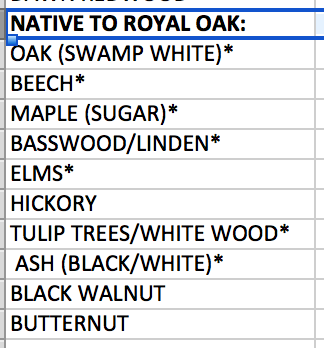
I removed the three nut trees that were mentioned by only one of the two sources: hickory, black walnut, and butternut.
I deleted ash and elm, given the decimation of those species, respectively, by the Emerald ash borer, beginning in Michigan in 2002, and the Dutch elm disease, caused by a member of the sac fungi (Ascomycota) and spread by elm bark beetles, which arrived in Michigan in 1950.
Finally, I took beech and maple off the list, too, as one beech and three maples are already growing in our yard.
That left three possibilities:
- Swamp white oak
- Basswood (a.k.a. Linden)
- Tulip Tree (a.k.a. White Wood).
And, I know absolutely nothing about any of these three tree species.
While I learn a little bit about them (including if they’re available to purchase and if they are, if they would do well here now, given that Royal Oak has been drained, the Red Run stuck in a pipe underground, and a lot of impermeable surfaces laid in the city) . . . I look forward, leaving you with a charming, but also quite practical, essay written by Evelyn Glass, a fifth-grade Royal Oak student, in 1929.
How to plant a tree
ARBOR DAY
The children of Whittier School celebrated Arbor Day, Wednesday, May 1. Arbor Day is a day that each state puts aside to plant trees and shrubs. If we did not plant trees every year there soon would be no trees left.
I will tell you how to plant a tree. First, dig a hole bigger than the tree requires so that it will have room enough to grow. Trim all broken branches or nearly broken branches and then put the tree in the middle of the hole. Then sprinkle rich dirt around the roots and cover up and stamp down the dirt all around. If it is in the growing season, water the tree when first planted but don’t keep it up. Artificial water is not as good as rain.
Some of the common trees of Michigan to plant are the poplar, elm, willow and umbrella trees. There are also many other that I won’t name.
Don’t forget that “He who plants a tree plants love.”
by Evelyn Glass, whittier 5a, reprinted in ROYAL OAK TWIGS AND ACORNS PLUS: ARTICLES, ESSAYS, LETTERS AND OTHER HISTORICAL WRITINGS” COMPILED BY DAVID G. PENNEY AND LOUIS A. LANE (ROYAL OAK, MI: LITTLE ACORN PRESS, 2008, 2ND ED., P. 261.)


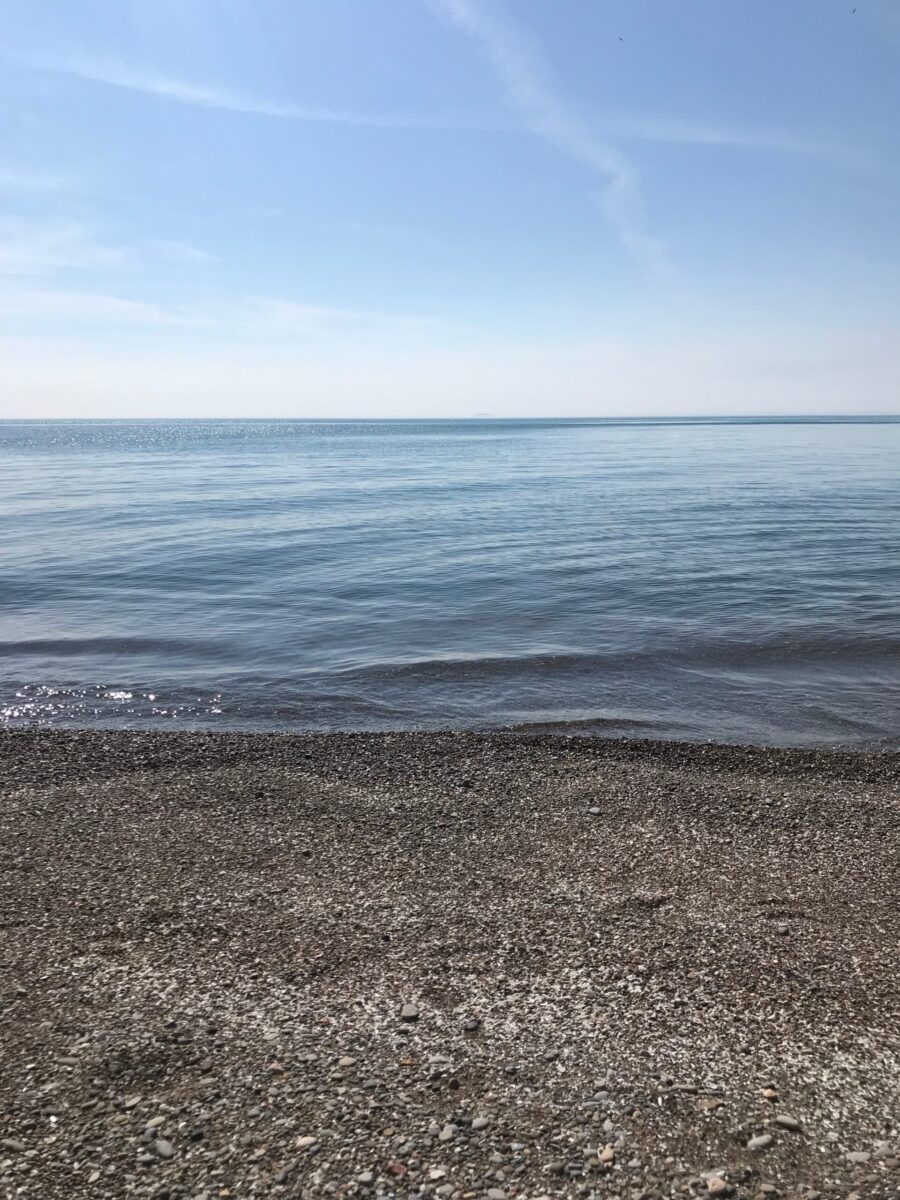

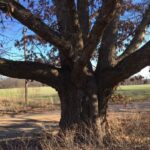
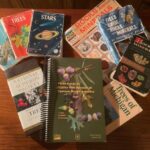

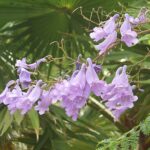

Very nice! I love a history lesson. Note: Tulip trees leave a disgusting mess when their petals fall off.
Thanks for the warning!